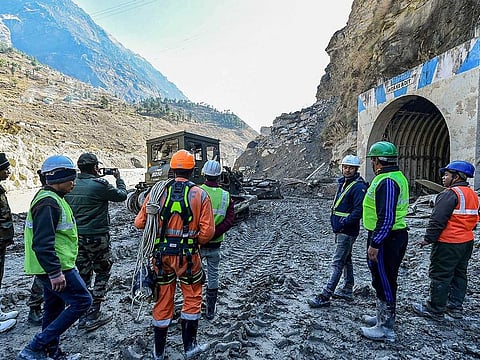Lesson from Indian disaster: Handle Himalayas with care
Reckless human activities can only end up causing more harm to the fragile eco system

On February 6, a day before India woke up to a disaster in the Himalayas, satellite images showed beautiful snow-covered Nanda Devi peak, India’s second highest, glistening in winter sun. Satellite images of the following day depicted a dramatically altered landscape and destruction caused by falling ice, mud, rocks into a deep valley in Uttarakhand.
A massive train of rocks and mud mixed with cold water violently hurled down the river systems, destroying bridges, dams, power projects, tunnels and everything else that came in its path. Dozens died and around 170 are missing, feared buried in man-made tunnels built to tame mountain rivers to harness energy.
Experts are still clueless on what triggered this massive avalanche and assessments vary from glacier water break to landslides. The satellite images offered some clues, geologists say rocks and ice hanging from glaciers plummeted almost two kilometres into the valley of Rishi Ganga, a glacier river that joins other rivers downstream to become the mighty Ganges.
The falling debris dammed the Rishi Ganga, creating a lake that eventually burst on February 7. Ten kilometres downstream at a village where Rishi Ganga merges into Dhauli Ganga river, this torrent roared past a bridge and a power plant.
Soon after, it destroyed another power plant at Tapovan, at a distance of almost 20 kilometres from where it began. While, hundreds of rescue workers are drilling into tunnels to rescue the missing, water is building up again at the same spot from where this torrent originated in Rishi Ganga Valley.
Environment experts and local activists have been warning against construction of dams and power projects, activities that involve digging and blasting mountainsides in this fragile eco system. The Uttarakhand state sits on the sub-Himalayan slope, between the plains in south, high peaks in north and is the source of the country’s largest river systems.
Any ecological disturbance in the mountains has disastrous consequences for the valleys and plains. In 2013, over 5,700 people died when flood water caused by melting ice and rainfall ravaged communities downstream.
These disasters are warning signals that the Himalayas need to be handled with utmost care. Over a billion people — 500 million in South Asia and 500 million in China — directly depend on this eco system and reckless human activities may contribute to disasters caused by climate change.
Melting of ice leads to formation of glacier lakes — like the one in Rishi Ganga — holding enormous quantity of water in naturally-formed dams. Fortunately, the Uttarakhand disaster on February 7 happened in winter when these lakes hold less water, reducing the impact downstream.
Sign up for the Daily Briefing
Get the latest news and updates straight to your inbox



